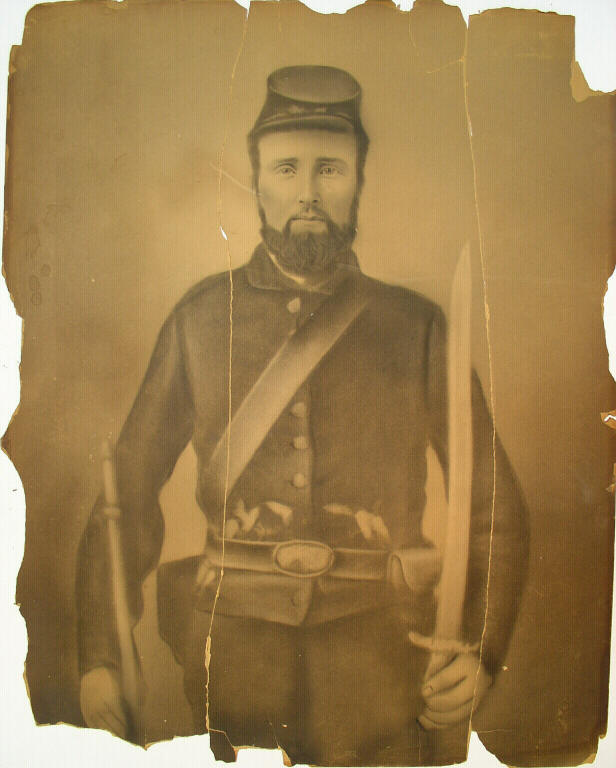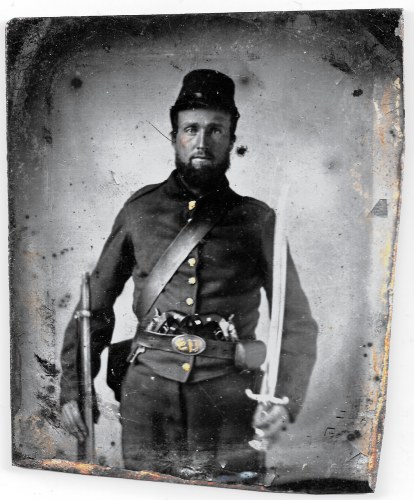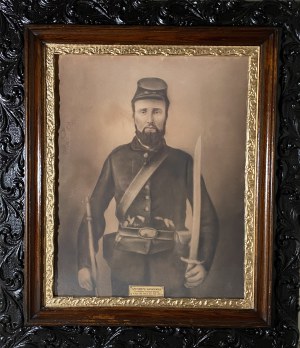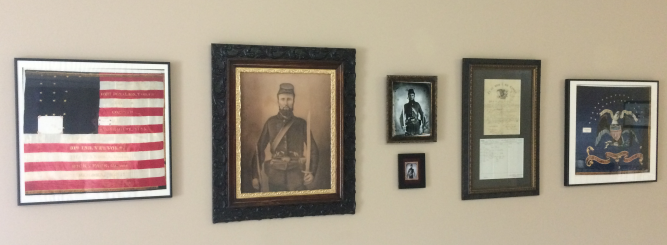The Portraits of Andrew Gosnell
The "crayon" portrait and the search for the original photo
In 1997 yours truly, the author of this website began Civil War reenacting. This rekindled my interest in Civil War history which made me think about the large portrait of a bearded man with a sword that I remembered seeing at my grandparents home as a teenager. I asked my Uncles if they knew who that person was. They told me that it was my Great Great Grandfather, Andrew Gosnell and that my Great Aunt had it in her basement. We borrowed it to take photos of it in 1997, and later she gave it to me in April of 2000. This is the large portrait shown below.

Andrew Gosnell, 1835 - 1896
31st Indiana Volunteer Infantry
This portrait of Andrew Gosnell first hung on the wall of the Gosnell residence and later at the residence of his daughter (My Great Grandmother) Bertha Ann Gosnell Cummins. The portrait measures about 16"w. x 20"h. in size and was framed in a frame that is shown near the bottom of this page.
This "crayon" portrait is an enlargement of a smaller photo of him. The picture frame was deteriorated and the portrait was broken into 3 major pieces and was crumbling. The portrait paper is on a heavy photo board that is acidic, giving it a brownish hue. The wooden backing broke in three pieces causing the cracks in the portrait board. On the back of the portrait written in cursive is "Mrs. Gosnell". Another unreadable name is on the back which we believe to be the Photographer or the business which may have enlarged it. Andrew is a private in this portrait. He was promoted to Corporal in July of 1862.
Conservation of this portrait was finished in December of 2016 by the Heller Conservation Services of Tennessee. A "crayon" portrait is made using an original print or negative which is enlarged with a special enlargement camera to make a faint photographic image onto larger photographic paper. The enlarged image is then drawn upon using various crayons and methods to make the final image. See "Restoring the original frame and recreating the Portrait:" (below)
Search for the original photo of Andrew:
Ever since re-discovering the above portrait we've had hopes of someday finding the original photo of Andrew. I asked family members about its whereabouts, searched the internet, civil war shows and antique stores hoping that maybe it would be found. On December 10, 2016, while going through my Uncle's estate, the original photo from which the above portrait was made was found by my cousin, loose in a box in an attic closet. I was filled with great excitement of the news and in January of 2017 I made the trip back home to see it for the first time. My hands were shaking when looking upon the very image my Great Great Grandfather posed for, over 156 years ago. Here it is below.

Andrew Gosnell
Image from the original tintype
The photo is a black lacquer tintype of irregular shape and measures 2-5/8"w x 3-1/4"h overall. It appears to have been held in a rectangular case at one time with a double elliptical (rectangular with round corners) mat due to the faint outline of where a mat was. His jacket buttons have been hand colored with gold paint as well as the reverse US on his belt buckle. A slight tinting of rose can be seen on his cheeks. To learn more about what Andrew is wearing see the "Uniforms of the Regiment" web page. For more information on the arms he has in the photo see the "Arms of the Regiment" web page.
Estimating when and where the photo was taken:
There are some clues as to when and where this photo was taken.
From the above clues, it is estimated that the photo was made between September 22, 1861 and February 1862 at either Evansville, IN, Henderson, KY, Spottsville, KY or Calhoun, KY. There was a "Daguerreotype" tent set up in camp at Calhoun.
Why was the Original Photo Found where it was?:
My Great Grandmother, Bertha Ann Gosnell Cummins was born in 1880. Sometime in the 1950's, she and her husband Wyat Elmer Cummins moved in to the home of her Daughter, my Grandmother, Ruth Cummins Hewitt and Grandfather Edwin Hewitt and my Uncles Max and Reese Hewitt. Wyatt passed away at the age of 84 in 1960 and Bertha passed away in 1969 at the age of 89. The box that the tintype photo was found in had other paperwork in it with dated items from the 1950's. This box and the large 16" x 20" portrait would have wound up at my Grandparents house when Bertha and Wyatt moved in with their belongings. I am assuming that my grandparents either never looked into this box from the 1950's or else forgot about it. I believe that the large portrait ended up at Dennis Cummin's house (their son) just after Bertha passed away in 1969. Uncle Dennis passed away in 1980 leaving the portrait with his wife, Evelyn (my Great Aunt). When I asked my Uncles about the possible whereabouts of an original photograph, they never knew of such a photo. My Grandmother, Ruth, did some geneology work in the 1970's and obtained a document listing Andrew's service record from the Archives Department of the Indiana Adjutant General's Office.
Type of Image Process:
A tintype or ferrotype used an iron sheet that was coated with a black lacquer where upon an image was developed. The process was patented in 1856 and enjoyed popularity until the early 1900's. The process leaves a reversed image, like what one would see in a mirror. During the Civil War the following photographic processes were in use; Daguerreotype, Ambrotype, Tintype and Carte de Vista (later called CDV). To learn more about how a tintype photo was made, watch this YouTube video using the link below.
Restoring the original frame and recreating the Portrait:
During the conservation process, Heller Conservation took high quality images of this portrait. The original image was placed in a "solander" box for safe storage. Using the high quality image, I was able to "photo shop" out the cracks and missing pieces. The original frame is actually a combination of 3 separate frames; an inner one with an ornate raised design painted in gold, a middle frame of exposed wood, and the outer frame that is 2-1/4" wide with large ornate raised or bas-relief design painted a dark brown. The outer frame's molded design was severely damaged by water. About 1-1/2" of the molding was completely lost along the entire lower side of the frame and up about 3" on the left side. Using a molding compound a copy was made of the right side that was in good condition. The mold was matched up with the remaining relief and a clear resin was used to recreate the original design material that was lost. The frame was painted with a matching color and the gold inner section of the frame was also restored and painted. Below is the restored portrait and frame along with the 31st Indiana V.I. wall display. The original portrait and frame are estimated to have been made in the late 1880's to 1890's, no date has been found.


created with
Website Builder .